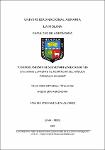Mostrar el registro sencillo del ítem
Comportamiento de nueve portainjertos de Vid (Vitis vinifera L.) frente al nemátodo del nódulo (Meloidogyne incognita)
| dc.contributor.advisor | Palomo Herrera, Ángel Alfonso | |
| dc.contributor.author | Oliva Alvarez, Yashira Steffani | |
| dc.date.accessioned | 2022-06-16T20:51:05Z | |
| dc.date.available | 2022-06-16T20:51:05Z | |
| dc.date.issued | 2022 | |
| dc.identifier.uri | https://hdl.handle.net/20.500.12996/5389 | |
| dc.description | Universidad Nacional Agraria La Molina. Facultad de Agronomía. Departamento Académico de Fitopatología | es_PE |
| dc.description.abstract | Se evaluaron nueve cultivares de portainjertos para vid (Vitis vinifera L.): Richter 110 (R110), Paulsen 1103 (Paulsen) y Richter 99 (R99), producidos por la hibridación de Vitis berlandieri x Vitis rupestris, SO4 y Telek-Kober 5BB (5BB), producidos por la hibridación de Vitis berlandieri x Vitis riparia, MGT 101-14 producido por la hibridación Vitis riparia x Vitis rupestris, Salt Creek y Dog Ridge provenientes de la especie Vitis champinii, y Quebranta proveniente de la especie Vitis vinifera; para determinar sus comportamientos frente a una densidad poblacional de Meloidogyne incognita. A los 5 meses de inoculadas las plantas, se evaluaron las variables de población, tasa de reproducción (Tr), nodulación - utilizando la escala Zeck y la escala PIM- y crecimiento de la planta. El cultivar Quebranta presentó mayor población y Tr, con 37598 nemátodos y 0.47 respectivamente, y el cultivar Dog Ridge presentó menor población y Tr, con valores iguales a cero, logrando anular por completo a M. incognita; sin embargo, la mayor población obtenida fue menor a la inoculada inicialmente, por consecuencia no fue posible usar el sistema de evaluación propuesto por Dropkin y Nelson. En escalas de nodulación PIM y Zeck, los cultivares 5BB y Dog Ridge presentaron menor y mayor valor respectivamente, siendo grado menor 0.00 para ambas escalas, y grado mayor 3.00 para escala PIM y 3.33 para escala Zeck. En parámetros de crecimiento, las variables que presentaron diferencias significativas fueron longitud de entrenudo, número de yemas, número de brotes, peso fresco de parte aérea y peso fresco de raíz, con valores bajos en los cultivares R110, MGT 101-14, R99 y 5BB, y valores altos en los cultivares Quebranta y Dog Ridge. En peso seco de parte aérea, no se observó diferencias significativas, debido a que registró valores bajos, y el análisis de variancia no detectó diferencias entre ellas. | es_PE |
| dc.description.abstract | Nine rootstock cultivars for vine (Vitis vinifera L.) were evaluated: Richter 110 (R110), Paulsen 1103 (Paulsen) and Richter 99 (R99), produced by the hybridization of Vitis berlandieri x Vitis rupestris, SO4 and Telek-Kober 5BB (5BB), produced by the hybridization of Vitis berlandieri x Vitis riparia, MGT 101-14 produced by the hybridization Vitis riparia x Vitis rupestris, Salt Creek and Dog Ridge from the species Vitis champinii, and Quebranta from the species Vitis vinifera; to determine their behaviors against a population density of Meloidogyne incognita. At 5 months after the plants were inoculated, the population variables, reproduction rate (Tr), nodulation -using the Zeck scale and the PIM scale- and plant growth were evaluated. The cultivar Quebranta presented a higher population and Tr, with 37598 nematodes and 0.47 respectively, and the cultivar Dog Ridge presented a lower population and Tr, with values equal to zero, managing to completely annul M. incognita; However, the largest population obtained was smaller than the one initially inoculated; consequently, it was not possible to use the evaluation system proposed by Dropkin and Nelson. In the PIM and Zeck nodulation scales, the cultivars 5BB and Dog Ridge presented lower and higher values respectively, being a lower grade 0.00 for both scales, and a higher grade 3.00 for the PIM scale and 3.33 for the Zeck scale. In growth parameters, the variables that presented significant differences were internode length, number of buds, number of shoots, fresh weight of aerial part and fresh weight of root, with low values in cultivars R110, MGT 101-14, R99 and 5BB, and high values in Quebranta and Dog Ridge cultivars. In dry weight of the aerial part, no significant differences were observed, due to the fact that it registered low values, and the analysis of variance did not detect differences between them. | en_US |
| dc.format | application/pdf | en_US |
| dc.language.iso | spa | es_PE |
| dc.publisher | Universidad Nacional Agraria La Molina | es_PE |
| dc.rights | info:eu-repo/semantics/openAccess | en_US |
| dc.rights.uri | https://creativecommons.org/licenses/by-nc-nd/4.0/ | * |
| dc.subject | Vitis vinifera | es_PE |
| dc.subject | Portainjertos | es_PE |
| dc.subject | Evaluación | es_PE |
| dc.subject | Perú | es_PE |
| dc.subject | Meloidogyne incognita | es_PE |
| dc.subject | Nematodos de las plantas | es_PE |
| dc.subject | Resistencia a las plagas | es_PE |
| dc.subject | Control de plagas | es_PE |
| dc.subject | Control químico | es_PE |
| dc.subject | Plagas | es_PE |
| dc.title | Comportamiento de nueve portainjertos de Vid (Vitis vinifera L.) frente al nemátodo del nódulo (Meloidogyne incognita) | es_PE |
| dc.type | info:eu-repo/semantics/bachelorThesis | en_US |
| thesis.degree.discipline | Agronomía | es_PE |
| thesis.degree.grantor | Universidad Nacional Agraria La Molina. Facultad de Agronomía | es_PE |
| thesis.degree.name | Ingeniero Agrónomo | es_PE |
| dc.subject.ocde | https://purl.org/pe-repo/ocde/ford#4.01.06 | es_PE |
| renati.author.dni | 72520405 | es_PE |
| dc.publisher.country | PE | es_PE |
| dc.type.version | info:eu-repo/semantics/publishedVersion | en_US |
| renati.advisor.orcid | https://orcid.org/0000-0003-2208-3620 | es_PE |
| renati.advisor.dni | 06769319 | es_PE |
| renati.type | https://purl.org/pe-repo/renati/type#tesis | es_PE |
| renati.level | https://purl.org/pe-repo/renati/level#tituloProfesional | es_PE |
| renati.discipline | 811036 | es_PE |
| renati.juror | Pacheco Avalos, Alejandro | |
| renati.juror | Parodi Macedo, Guillermo | |
| renati.juror | Huahua Zaquinaula, Medali Heidi |
Ficheros en el ítem
Este ítem aparece en la(s) siguiente(s) colección(ones)
-
AGR-FP Tesis [62]



